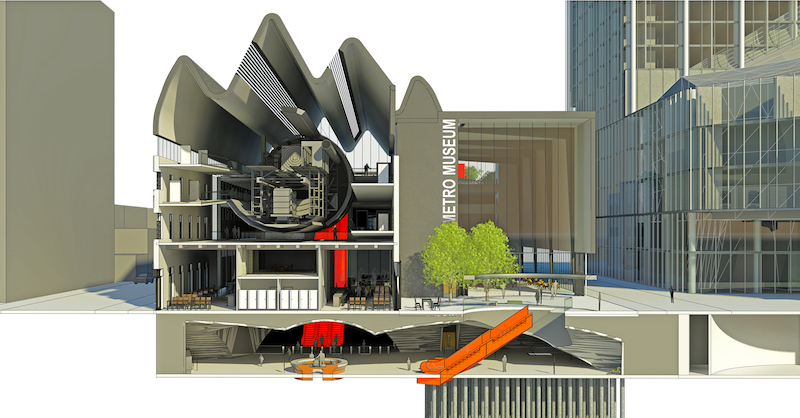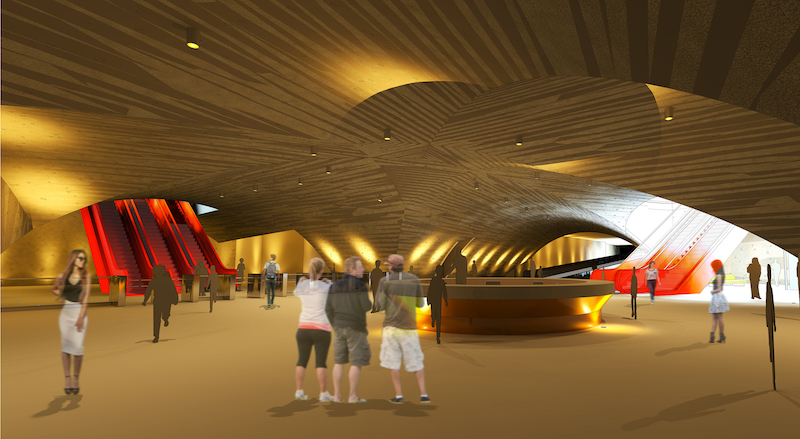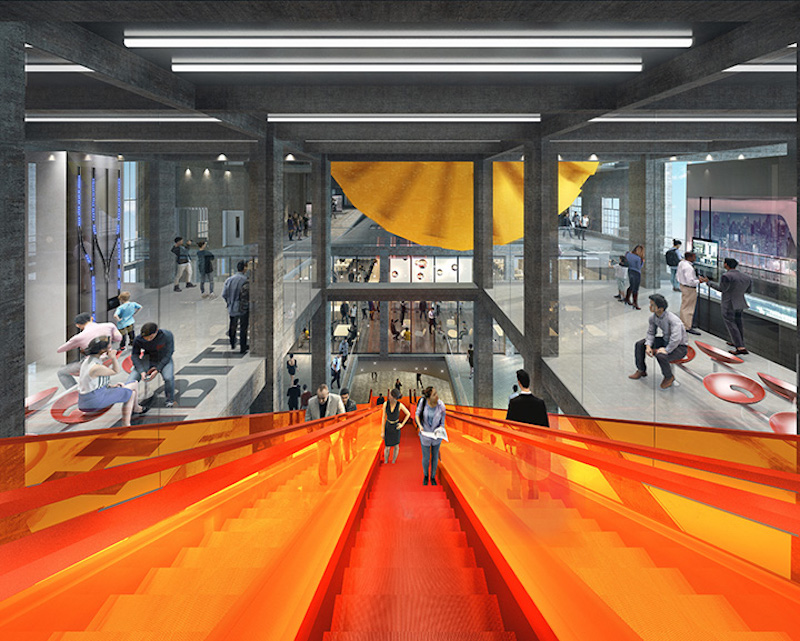Two 100-year-old German warehouses in Wuhan, China, central China’s most populous city, will be conjoined to create a 150,000-sf Metro Museum. The new building will use 75,000 sf of the site for the museum while 64,000 sf will be for commercial use, including restaurants, a café, and a gift shop.
One of the museums entrances will be underground inside the Line 7 Metro Station. Escalators will provide visitors entering via this entrance with views of each museum floor through incased glass as they ascend to the top of the four-level museum. The museum’s focal point is a tunnel-boring machine used to excavate metro tunnels. The boring machine extends two floors and is visible through floor-to-ceiling windows outside of the building. A circular ramp allows visitors to gain a close-up view of the parts and details of the machine.
 Rendering courtesy of GreenbergFarrow.
Rendering courtesy of GreenbergFarrow.
Once arriving at the fourth floor, guests will walk through a Visitor’s Center where they can explore the museum’s cabinet of curiosities (small collections of objects) as they descend an atria spiral staircase from the top floor to the ground floor. The ground level includes restaurants, a sculpture garden, and an auditorium.
“Our goal was to optimize the space to function as both a place of curiosity and socialization, with multiple revenue streams for the museum. Generating revenue beyond the admission fee is critical to the fiscal health of museums today,” says Rodney Abney, Principal of GreenbergFarrow, in a release.
 Rendering courtesy of GreenbergFarrow.
Rendering courtesy of GreenbergFarrow.
The new museum will become the largest and most comprehensive Metro Museum in China. It is expected to cost $40.8 million and open in September 2019.
 Rendering courtesy of GreenbergFarrow.
Rendering courtesy of GreenbergFarrow.
Rendering courtesy of GreenbergFarrow.
Related Stories
| Mar 29, 2012
Construction completed on Las Vegas’ newest performing arts center
The Smith Center will be the first major multi-purpose performance center in the U.S. to earn Silver LEED certification.
| Mar 5, 2012
Franklin Institute in Philadelphia selects Skanska to construct new pavilion
The building has been designed by SaylorGregg Architects and will apply for LEED Silver certification.
| Dec 5, 2011
Summit Design+Build begins renovation of Chicago’s Esquire Theatre
The 33,000 square foot building will undergo an extensive structural remodel and core & shell build-out changing the building’s use from a movie theater to a high-end retail center.
| Nov 9, 2011
Lincoln Center Pavilion wins national architecture and engineering award
The project team members include owner Lincoln Center for the Performing Arts, New York; design architect and interior designer of the restaurant, Diller Scofidio + Renfro, New York; executive architect, FXFOWLE, New York; and architect and interior designer of the film center, Rockwell Group, New York; structural engineer Arup (AISC Member), New York; and general contractor Turner Construction Company (AISC Member), New York.
| Oct 12, 2011
BIM Clarification and Codification in a Louisiana Sports Museum
The Louisiana State Sports Hall of Fame celebrates the sporting past, but it took innovative 3D planning and coordination of the future to deliver its contemporary design.
| Oct 12, 2011
Consigli Construction breaks ground for Bigelow Laboratory Center for Ocean Health
Consigli to build third phase of 64-acre Ocean Science and Education Campus, design by WBRC Architects , engineers in association with Perkins + Will
| Sep 12, 2011
Living Buildings: Are AEC Firms up to the Challenge?
Modular Architecture > You’ve done a LEED Gold or two, maybe even a LEED Platinum. But are you and your firm ready to take on the Living Building Challenge? Think twice before you say yes.
| Apr 13, 2011
Expanded Museum of the Moving Image provides a treat for the eyes
The expansion and renovation of the Museum of the Moving Image in the Astoria section of Queens, N.Y., involved a complete redesign of its first floor and the construction of a three-story 47,000-sf addition.
| Apr 12, 2011
Entrance pavilion adds subtle style to Natural History Museum of Los Angeles
A $13 million gift from the Otis Booth Foundation is funding a new entrance pavilion at the Natural History Museum of Los Angeles County. CO Architects, Los Angeles, is designing the frameless structure with an energy-efficient curtain wall, vertical suspension rods, and horizontal knife plates to make it as transparent as possible.
| Jan 21, 2011
Sustainable history center exhibits Fort Ticonderoga’s storied past
Fort Ticonderoga, in Ticonderoga, N.Y., along Lake Champlain, dates to 1755 and was the site of battles in the French and Indian War and the American Revolution. The new $20.8 million, 15,000-sf Deborah Clarke Mars Education Center pays homage to the French magasin du Roi (the King’s warehouse) at the fort.
















